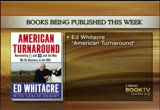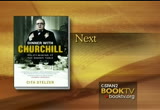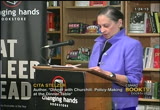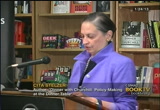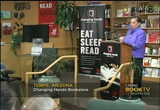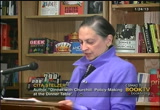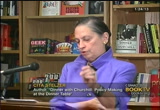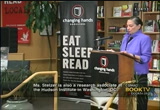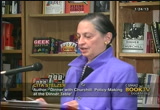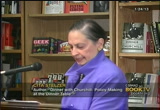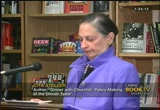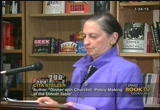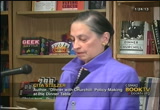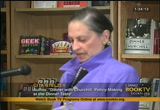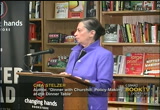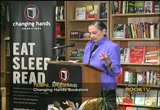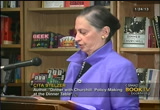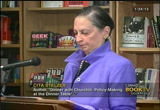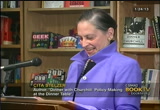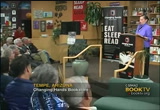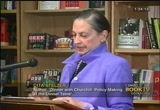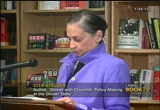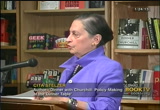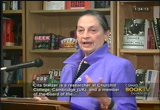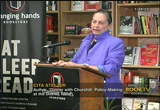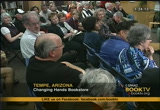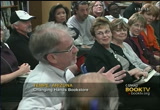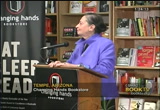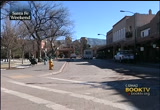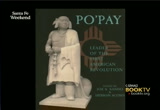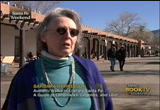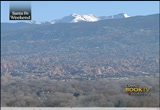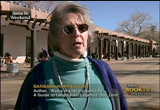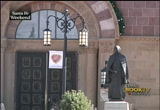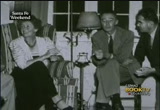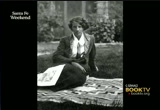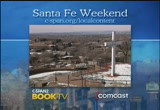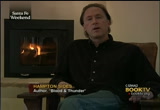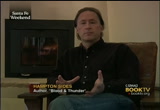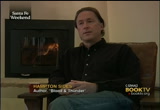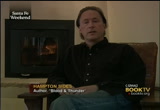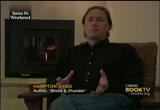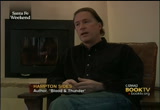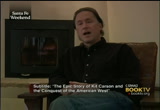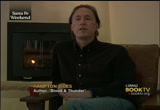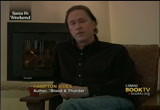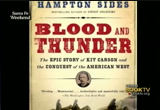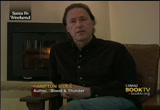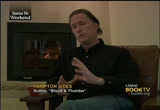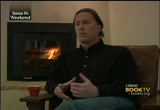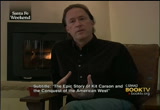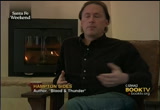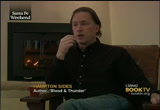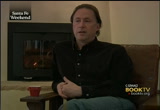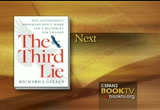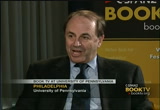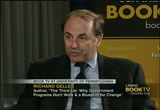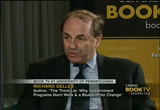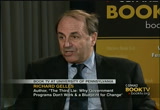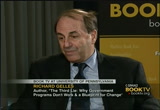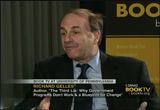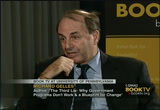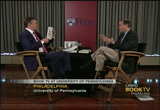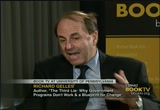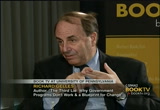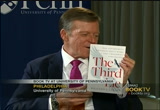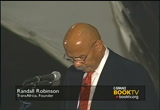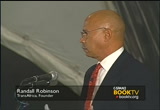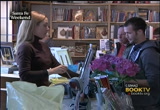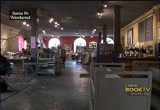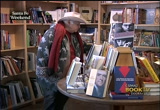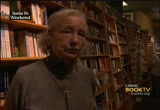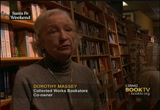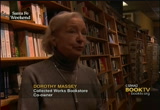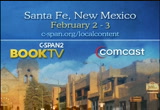tv Book TV CSPAN February 3, 2013 12:30am-2:00am EST
12:30 am
12:31 am
i'm delighted to see you here to talk about my new book "dinner with churchill: policy-making at the dinner table." since my book is all about the importance and dinners be assuredly not make you late for your own dinners. i will be brief. i want to whet your appetite so you'll buy my book. you want to -- i have lived with wrurnlg winston churchill for four years. it was wonderful. even though it took place in churchill college. i'm asked where i got the idea to add to the thousand already written. i have read many books about the man and notice many of the important accomplishments were achieved at dinners. sometimes at luncheons. so i began to wonder why that was so. why most of the deals that were
12:32 am
struck at the famous international conferences held during world war ii were made at or facilitated by dinners at which the leaders were more relaxed in a formal session. so i began digging in to the churchill archives. not do i find more famous dinners with president roosevelt and truman and stalin. there were keys of churchill carefully setting the stage for dinners with the general, april friends, and leading academics and a host, pardon the pun of interesting people they usually included twelve to fifteen people and often members of his own family. and staging the dippers is a right description. he loved to perform at these affairs. he loved company, he loved attention he got if he entertained and more important wood the guests. at one dinner he described the navel battle using wine classes
12:33 am
and decanter to show the position of the ship and blowing smoke from the cigar to imdate the -- imitate the cannon fire. the topic at wrurnlg's table were wide ranging. that hamilton woman was a great favorite of issue winston churchill and politics. his curiosity was boundless. many wrote to friend or recorded in the dire the conversation repeated the about dote and commented on the food he served. in addition, i found hundreds of bills he game at the london hotels. with guest lists, amended wine lists. many letters from winston churchill complaining about overbilling, thanking friends for gifts. arranging generous gifts for the hoaghts waiters all in the archives and set out in my book. i have produced many of the --
12:34 am
in my book in case any of you want to use them at the special party. the wine list might be harder to replicate since so many decades placed sin winston churchill placed the order. i have noted the musical choices should you be willing to hire a band. wroi about it because they shed light on the care winston churchill took to make the meals productive. they show how his staff strug told meet the requirement in remote places athey i describe his choice of and use of cigars to prolong after dinners discussion. my research told me what i ate and drank and with whom and how he interacted with staff. somehow my hero turned to reality. the human being with definite reactions. very negative reactions to white house cooking. to mixed cook tails served by
12:35 am
hosts and across the world. to cheap cigars which the u.s. military tried to get away with qvcing him. to arguments from the generals. and to diet warnings and suggestions from his wife. these were largely ignored. especially the one that involved his eating only tomatoes. as i dug to the material it became clear to me, peoples had an advantage over most kinds of meetings. they could be as long as he liked and in the case of dinners they run to the wee hours when he gathered strength and others tired. he the conversations became so extended meal times tended to prolong themselves to the afternoon or evening with luncheons lasting sometimes until half past three. a typical evening at checkers
12:36 am
the prime minister's country house would begin at 8:30 with champagne in the drawing room and dinner lasting from 9:00 to 10:00 and sigh impairs after the ladies excused. when the men rejoined the ladies twenty minutes later a movie would be shoafn even until wartime until midnight winston churchill would annoy to work and dictate and work until 2:00 in the morning. the next morning he would wake at 7:00 to start work again in bed. surrounded by staff and military personnel until lunch. the more i read the report of the meals by those lucky enough to attend them. the clearer it became they were working meals not social occasions winston churchill loved them. he used the hour the sphoant educate others about the policy to persuade them to go along and learn from the guests the latest and political social goes gossip
12:37 am
and get news from around the world. there was no 24-news cycle in those dais. private reports of well-placed guests were often the best source of what was going on in se the soviet union. his guests came from all walks of life both during the war they were mainly military and politicians british and american. and when winston churchill felt he could tolerate it he had to dine with charles. but there was always a purpose to the dinners toed a van his country's interest to explain, cajole, to learn, to exchange information, it was the conversation that mattered. the setting the table and the food were the stage which he would perform. here are two examples examples with important dib -- inners. white house in december of 1911 and a second one in 1942 when winston churchill after the
12:38 am
12:44 am
boarded brooklyn, new york had been a much admired society hosest in london. she was famous for inviting known political ebb my to dinner and seating them so facility discussion. churchill praised his mother in his interest she quote, let no cut let uncooked. he must have learned from her early on to manage a dinner for his own purposes. i describe how he employed the skill the attention to detail. at the birthday party din in teheran he arranged the seating himself. he had the construct the table how close together or far apart
12:45 am
they would be. imagine the staff persons spreading their elbows like this watching churchill for ate approval to make sure that the seating was the way he wanted it. at this important dinner, he would be meeting with president truman for the first time. churchill amended the menu to add another course. ham salad. and nobody knows what he had in mind when he added that course to the menu. the further on interpreters should they sit in between or slightly behind the participates? churchill decided to place them slightly behind. not at the dinner table. this arrangement once again facilitated the conversation. let me add a few words about the man liked to eat. the answer is church hill liked plain, simple food perfectly cooked. no french sauces or fancy pies or concoctions. as i said he didn't like the
12:46 am
chicken messed about with. his favorite meal would be clear consomme or turtle soup. never cream. it had to be quote, lipid. perhaps smoked salmon, meat, roasted chicken, game if it's seasoned or rare roast beef. he was after all english and december setter what he called his pudding ice cream and perhaps chocolate sauce and then appeal -- peeled pear. another word on consomme, which churchill loved. at the end of the working day about 2:00 a.m. the prime minister would say soup, out loud very loudly that was the signal that the working day was over. the secretaries could leave to begin typing up the memos and he would have the consummate before going to bed.
12:47 am
churchill loved all game. especially goose. and he raised geez on the farm at chart well. and one dinner, as he roasted goose laid in front, he said, quote, you carve, this goose was a friend of mine. in all of my research in churchill's life i never found a mention of a vegetable. and he made fun of vegetarians woman he called nut eaters. he quipped to -- both strict nut eaters. quote, well, gentleman, if you finished toying with your beet root we will get on with more important matters. and another case all the nut eaters and food faddists i have known died early after the long period of see kneel decay. another churchill favorite food was irish stew with plenty of onions and surprisingly sometimes pineapple. this is the meal that churchill
12:48 am
served to general eisenhower -- when they planned the innovation of europe. and of course, caviar, he loved caviar. he was thrilled when stalin sent him vats of caviar or harry brought it back as a gift from the soviet union. he ate small portions, when traveling he had the meal served on his, quote, tummy time. not on the clock. churchill loved picnics. whatever the place or the weather, even in wartime. he picnicked with roosevelt at hide park and picnicked on the bank with the ride with the generals, and in the north african desert with friends.
12:49 am
much has been said and written about churchill and alcohol. some true most not. some exaggerated. roosevelt had been told that church hill was a drunk. a charge one or two of the critics repeated. churchill did consume more alcohol than we're used today. not a great deal by the standards of the contemporary and drink didn't effect him or his work. churchill drank a small amount of whiskey with soda, no ice, in a glass about this big. they called it mouthwash. at lunch and dinner he drank a half bottle of champagne.
12:50 am
they sent him a case of the 1928 until the sum mys ran out in 1953. when churchill died in 1965 he had only gone through the 1934 vintage. after his death, they ordered that all bottles imported to britain would have a black mourning ban stripped across the bottle. every dinner and important occasion throughout his life, was marked with champagne. after dinner, churchill drank brandy. neat. and, by the way, he drank brandy not port. early had his life a doctor recommended brandy instead of
12:51 am
port. this is one of the few times he followed a doctor's orders. perhaps knowing that port would be bad for what he called his indy, always patting his stomach when he said this. his indy jex something he suffered from given the meals he had with the likes of stalin. i think not. only two people wrote the
12:52 am
churchill was at worse from wear from alcohol. one of a soviet staff member reporting to stalin what he thought he wanted to hear. the second was a private secretary to anthony eden woo would have liked to report to his boss that church hill was drunk. he never would have been able to work as he did so successfully if alcohol had taken hold of him. churchill very much enjoyed the legend of his drinking and added to it by boosting the amount of he consumed. he was like a bulldog that could drink with the best of him. he 4 three uses the first a sheer pleasure the enjoyment of the flavor of good cigar and feeling relaxation that such a smoke brings. the second was as a trademark.
12:53 am
sorry. churchill was too shrewd a politician not to realize that the cigar had become an iconic symbol of the grit. in the face of adverse i are. just as fdr dispret holder had become the american president's symbol. the third use to extend the length of dinner to plan to sell the policy to learn from people. after dinner, lilt a good long cigar and pass around others. from his humidors and count on a another few hours of good talk at the time when others were exhausted but he was at the best. this was not always appreciated by the war weary admirals and generals that were often
12:54 am
included on the guest lists. but all in all, it was a part of dinner with church hill that most guests treasured and remembered and wrote about. it's a wonderful story about cigars and churchill's personal security in my book. it's too long to go in to tonight. i do hope you'll read it. a word about rationing. during the war years food and other commodities rationed. who was required for every dinner. his staff needed extra rations so the prime minister could get a summer white suit to meet with president roosevelt. and unuse rationed coupons were returned to the government. the british people suffered under rationing and churchill
12:55 am
wanted him to see that he was subject to the law. but churchill did benefit from gifts from fans around the world and at home. some british people had home grown food share with the prime minister, the king sent game from the lands. others sent fish from the streams or cheeses made on the farms. president roosevelt sent food parcels and a case of plum brandy. tangerines came from lisbon and hams from an americaned admirer and of course thousand of cigars from all over the world. churchill worried about the effects of rationing on the people's energy levels, their diet, their morale, spirit. he worried about everything. no detail was too trivial. for example, he worried that british beings would not get enough sugar to get through the winter. sugar was rationed. when he was asked by a staff what they should do about providing fish, he declared the
12:56 am
policy to be, quote, out most fish. the supply of salt and vinegar remain stable important for chips or french fies as we call them. i hope you'll read my book with new information about the wisdom of win winston churchill. there's an interesting story about eggs which is too complicated to tell you about here. i hope i bring to light the two sides of the great man. the effort he put in to getting adopted the policies he felt to be in his country's interest and the human side of chumpleg hill. his huge enjoyment of life, the excube rains and charm and energy and capacity for work. his kindness and humor. his courtesy to the guests and generosity with friends. he once promised, quote, i hope
12:57 am
i shall be able to provide a bottle of champagne and another for my friend. to quote a famous historian he was quite simply a great man. thank you. [applause] [inaudible] any questions or comments yes, sir? >> okay. thank you so much we welcome you to arizona. you made a reference to the second front that stalin wanted in europe in the west. and as i understand it 42
12:58 am
americans and british opened up a front in north africa and it pushed the germans out of north africa. and began an innovation in sizely and later the italian pee innocence will. -- peninsula. he was referring to an innovation of north of france. and was there intense conversations on this topic where they, you know, really got to the -- would not in the generals and five steps knew there wouldn't be a second front in europe in '42. they had to sell to stalin. the first night of the meeting in '42 stalin was unhappy at the dinner ended on sour note. the second night was a official banquet it was different. which -- and stalin to to --
12:59 am
would not be -- [inaudible] >> the eye tal yab innovation -- i tal began in-- i tal innovation was in '43. i noticed on wikipedia there was a mention about your book and the fact ha churchill had moved to the white house for three weeks and i found that unbelievable. that must have been fun times. but you said when you were talking that there were two dinners or two events and one of them involved the white house i think in 1911, you said . >> 1941 which is the one you are referring to. >> right. and great personal danger took a ship to washington. landed in washington right three or four dais before christmas and moved to the white house and stayed there for three weeks with the exception of a trip to
1:00 am
canada to give a speech and a few days he had in florida. he lived in the white house in a bedroom in the lincoln bedroom and lived with the president. mrs. roosevelt was not thrilled with the arrangement. she said that she put it winston kept franklin up too late. winston kept everybody up late. it wasn't just the president he was doing that too. ..
1:01 am
so i was glad you put that there, but i kind of wish it was earlier. but that was good. >> it's an important chapter. it showed a part of churchill's character that was very important. many other people of commented or got any other questions? >> churchill was known for being a poor money manager. all of the food that he thought, did you find bills that he actually paid for everything? he was kind of famous for not
1:02 am
being -- and various other things in his life. >> i don't know about the suits but most of the bills i've seen, and i've seen many of them, are stamped paid. for instance well all of the important dinners that he had for his son's 21st birthday's, they were paid. i i am not clear and that's an interesting question. i'm not clear when the dinner was and when the bill was paid so you bring up an interesting point. but they are all paid, all stamped paid in all of the bills are saved. not just a few of them. there are many, hundreds of them. everything is saved in the archives. >> was there in a rift created between churchill when --
1:03 am
[inaudible] >> i think by that time, churchill knew that what had been equal allies was no longer true and that the americans were really -- should have eisenhower as their leader. and by that time it was clear that the americans and the number of army people we had, it had to be eisenhower and not a british general. thank you very much. [applause]
1:04 am
♪ >> hello. i am barbara harrelson. we are here in santa fe yet the historic plaza and the palace of the governor which is the oldest public building in the united states. santa fe is the oldest capital in the united states and it has been here for more than 400 years. it's got lots of stories to tell and i have been conducting a
1:05 am
little walking tour of santa fe since 1996. so i would love to -- for you you to join meteors in santa fe stories. we are starting on the plaza in downtown santa fe because this is the heart of santa fe today as it has been from the very beginning of its founding. this is where community events still happen. this is where traditional christmas pageants take place in santa fe today as they have for the last couple of centuries and this is also where the first american revolution took place the pueblo revolt of 1680. i have a book here that some of you may want to read. it's called pope a leader of the first american revolution by a native american writer, joe sando and herman okoye. this is an important and not only in santa fe's history but in the history of the nation
1:06 am
because this was the first successful uprising by native peoples against the europeans and conquerors. and the pueblo people join together and forced the spanish out of santa fe into exile 300 miles south of here where they stayed for the next 13 years. our history and culture is so rich because of the predominant culture groups starting with the native people and they're very strong orals there are telling tradition. the books and alphabet for them to write down their stories, they advance their stories. they did rock art and told their story through their families and pass them down from generation to generation. even today the native people believe that the most sacred stories should only be passed down by word of mouth. another important influence on our literature and culture of course or the spanish are ruled
1:07 am
in santa fe for more than two centuries. and the first piece of literature to emerge from this arrow was actually written by a spanish officer who came here with the conquistadors and it is his first-hand account of the settling of this country and this part of the world and some of his famous battles. the title of the epic poem that he wrote was -- which simply means the history of new mexico. it is the earliest first-hand account and it was published in madrid in 1610. the original copy is here in our history library that is part of the museum of new mexico. now the third dominant culture are the americanamerican s who came here. remember santa fe was spanish for more than 200 years and then for 25 years we were a part of
1:08 am
mexico and then after the united states fought a war with mexico lead became a u.s. territory and the santa fe trail opens bringing in americans or the first quote unquote white man into this part of the world and so the impressions of some of those early traders and settlers who came across the santa fe trail are an important part of our literature because they reported their experiences and their impressions of santa fe combat the old royal city. and many of them could not believe that a royal city had houses made of mud. there was a little bit of culture shock. others took the exotic feel of the place in the beautiful mountain setting right away and that is true today. santa fe inspires strong emotions. for example a man named chris wilson who is an architectural historian at the university of new mexico wrote a book not too long ago called the myth of
1:09 am
santa fe in which he documents the evolution of santa fe's style and quiet the civic fathers decided that we needed to see the look of an earlier time to attract tourism and why he feels that is not necessarily an advantage for santa fe's culture and certainly not to advance authentic indigenous architecture. a famous novel was written in the latter part of the 19th century that is still in print today. it has nothing at all to do with new mexico. it was an accident of chance that the author was general lou wallace who wrote ben-hur, a tale of the christ. the last three chapters were written in the palace of the governors in santa fe new mexico because general lee wallace has been called upon by the president of the united states to come here and service territorial governor and try to
1:10 am
-- the lincoln county warrant some of the other problems in this very wild territory. i mean gunbattles were taking place in land grabs were taking place all over new mexico. it was a really wild west. while he was here he had to grapple with billy the kid and billy the kid is a real-life historical character who has inspired probably more writing, fiction and nonfiction, than anyone else in new mexico's history. some of the letters that billy the kid row two general lee wallace asking him to honor the offer of a pardon which billy the kid said that they got runner reneged on, some of those letters are in our history library and what surprised me, they have only been acquired in the last two years. what surprised me is that billy the kid was literate and that his handwriting was pretty good. but the legends about really go
1:11 am
on and on and on. the man who killed billy the kid pat garrett wrote his story called the autobiography of billy the kid. and then one of the foremost living billy the kid experts, frederick noland, he has annotated that book so there is much literature out there fiction and nonfiction if you find out what you think about billy the kid. we are near the famous santa fe cathedral, the cathedral basilica of st. frances who is the patron saint of santa fe. santa fe actually means holy faith and there are lots of stories about santa fe and his spirituality but one of the most famous is the will of catherine novel which is historical fiction based on the real-life archbishop who came to santa fe in 1853 as santa fe's first bishop and later first
1:12 am
archbishop. he was sent here here to make reforms in a subsequently ended up excommunicating some of the more popular hispanic priests in northern new mexico. a famous book about the same man and the same era was written by the late paul hogan and it won the pulitzer prize for biography. it was called let me of santa fe, his life and times. that is it book that should be read side-by-side along with the novel. we are here at 109 e.'s palace which is the name of a storefront. it's also the name of a book, a nonfiction book written by jenae coneff that tells the back story if you will some of the personal stories of the scientist to came here to work on the manhattan project during world war ii to build the atomic von. robert oppenheimer, who had been selected to lead the project and
1:13 am
oppenheimer new new mexico ended that he had come here is a boy and spent summers at the ranch school in los alamos. he thought i would be the perfect place to do his secret project. he is very well respected and educated scientist who has fled nazi europe and they were recruited to work on this project. so they rode the train out here. they were met at the station and driven into town. they would have checked in at the store which was supposed to look like just a regular tourist store in santa fe. it was operated by a man -- woman named dorothy mckibben that oppenheimer had personally recruited and she gave them instructions. los alamos was guarded with a secure perimeter and they wouldn't be coming back to santa
1:14 am
fe that often but if they did come, that they were to use not their own names and make up some kind of a name and not say very much at all because they all spoke with an accident. they managed to build the bomb and helped in the war earlier. but they definitely had an impact on santa fe. there were rumors about nuclear secrets being traded to the russians and we know now that was done here in santa fe. another book that is very close to my heart that i want to tell you about is an older book but it too is nonfiction. it is they pass the -- the house of auto weybridge. taking and lots of aspects of santa fe's history and culture, how we are a land that's back t -- stark contrast in the old
1:15 am
and the new. that is why i think it addresses all those issues. more than for example 109 e.'s palace which is specifically about the project and the people who were involved in it. so we have flooded your appetite to learn more about santa fe in new mexico and its literary heritage and i'm so delighted to have been able to take you on just a a few stops and you just touch on a few of the important works of literature and hope that it will prompt you to explore more on your own. next hampton sides sat down with booktv to discuss his book "blood and thunder" the epic story of kit carson and the conquest of the american west. kit carson is one of those guys that i think he's almost better known for his fictional aspect.
1:16 am
i mean this is a guy that was the subject of hundreds of comic books and b's original pulp novels that were called blood and thunder's and bad tv shows and bad movies. so what we know about this guy is a skewed and sort of muddied by a cumulative history of fictionalizing. so when i decided to write a book about him i kind of wanted to peel back the layers of all the fiction tried to get to the real guy and turn out the real guy was infinitely more interesting than the fictional character. i just found that he was one of these almost -- characters even though he was in a sense powerless and he was an illiterate runaway from missouri, he knew everyone in the west on the western stage. he intersected with all the historical figures and will was
1:17 am
intimately involved in the exploration and the west and the mexican-american war, in the civil war and the indian war. this was a guy who intersected with big history but in an intimate way. so i decided to devote a book and about four or five years of my life to trying to figure out who this guy was, kit carson. carson came out here in a way to escape america. he was a runway and he had heard all the stories about the wild west and wanted to be one of these mountain men, one of these for trappers. he did come out to mexico and intersected with these guys. he became an intimate part of their world which was mainly a french-based culture. he learned french and became fluent in french and lived with these guys and learn the river systems of the west. basically hunting pelts.
1:18 am
of course he knew all the rivers because that was the key to understanding the topography and understanding havoc around here. when the u.s. topographical course sent an expedition under john c. fremont to explore the west they needed a guide and fremont realize that these mountain men knew the west better than anyone so he hired kit carson as a guide. carson acquitted himself himself very well on these expeditions. had he saved many people's lives and kept the expedition on track and so he became in fremont's report which became a best-selling book, carson becomes kind of the hero in the stories. but no one could seem to find this guy because he was living in mexico and was never coming back each so he was kind of this
1:19 am
mythic character that people wanted to know a little bit more about. and so, when the "blood and thunder" looks became more popular kit carson was often the central character in the stories. these authors back east to read these terrible stories -- i would dare you to read them actually. they are not good in terms of literature but these authors never really made any attempt to understand who the real kit carson was. they didn't give his consent to use his name. kit carson did not make any money off of these books. he hated these books because they were gross exaggerations and they set up this kind of caricature that he had to spend the rest of his life trying to live down. they would say things like cape carson was the kind of man who would kill to indians before breakfast which was considered a good thing back then.
1:20 am
in fact he was married to a native american and was a very close friend to many tribes in the west. so these were the kinds of things he had to spend most of the rest of his life living down. he did not understand where this was coming from, why people back east sowed desperately need this hero, this character who would personify manifest destiny and whenever he went back east people refuse to believe that he was the real kit carson because the real kit carson was five-foot 4 inches and was awkward around people. he spent most of his life on a mule so he had this awkward gait that -- he wasn't his heroic action figure type guide that was portrayed in the "blood and thunder" so there was this disconnect. people would say you are not the
1:21 am
kind of kit carson i'm looking for. they were sorely disappointed. so i spent a lot of time in the book sort of trying to explore the ways in which carson tried to deal with this celebrity. it was a very awkward thing for him. these "blood and thunder" books, carson had another problem which was he could not read them because he was illiterate. so we had to have other people around the campfire read these books to him, which was a source of embarrassment and it just made it all the worse. there was one time and which carson's celebrity from the sub five intersected with the real kit carson and that was in the 1840s when he got an assignment to go try to find a woman, a white woman ann flight was her name, who had been kidnapped by apache.
1:22 am
he followed the trail for five, six, seven baby closer to two weeks before he did find ann white and the element of surprise was compromised and various things happened and she ended up getting killed. one day when carson and his men went down to the campsite to sift through her belongings, what did they find? they found a "blood and thunder" book that she had evidently been reading and the star of this subfive book was kit carson the plot line of the book was kit carson went out to rescue a woman who had been kidnapped by indians. here she was reading this book thinking perhaps the kit carson was near. she gets killed and carson and the real story is not able to save this woman. this just haunted him for the rest of his life and he ordered the book burned.
1:23 am
he thought the "blood and thunder" books were terrible. there were interesting ways in which the mythology intersects with reality and the story. one of the most famous stories about kit carson i was told during this time that is actually true -- though you have to understand a lot of the stories aren't true but the more you dig into them you find, pretty suspicious. but one of the ones that is actually true is during the mexican war he was in the battle for san diego called san pascual. the american army had become surrounded by a mexican californian army that was almost like don quixote or something. they were remarkably proficient and they were just butchering the american army. they were really good at it and the american soldiers were getting gored and just ripped to pieces by these long lances,
1:24 am
almost like adjusting kind of thing in medieval times. so they were completely surrounded and it was just a matter of time before they were all going to be killed or go kit carson was given the assignment to try to make it to san diego where there were supposedly some marines out in the bay on a ship and maybe go and get help somehow. so carson at night slips through this ring of mexican soldiers somehow but in the course of slipping through this line of soldiers, he lost his shoe and he had to walk 30 miles to san diego barefoot across this country that was just unbelievably difficult and and full of cat this. so he does do this and makes it to san diego, makes it to the ship. they immediately taken to the
1:25 am
infirmary and his feet are completely torn up and he's just a bloody mess. he cannot walk but he gets there and he alerts the marines to what is happening. the marines come and save the american army and carson meanwhile is in the hospital were three or four weeks because his feet to come infected. he never told the story and never talked about it. it was something that he was always reluctant to put himself at the center of the story but in the way he saved the american army and the situation. there are stories like this throughout his life where whenever there is something going on that the chips are down, cut carson somehow gets the assignment to fix the situation and he does. this is certainly one of the best-known. by the end of his life when he dies comp of the transcontinental railroad is being billed. most of the tribes that he was close to have been rounded up
1:26 am
and sent to various reservations his main impact though and i think what what is probably most famous for his for one of the last things he did in his life which was he -- the round up of the novel how indians. depending on how you count the number among tribes, and bloodlines and the sort of thing it's the largest tribe in the united states. he succeeded in rounding up the novel how i'm moving them to a reservation 500 miles away come, and the construction of the novel of culture and his long walk as they called it is something that it's almost like it happened yesterday in terms of the navajo and their memory of this. and they hate carson. they think he is a genocidal character and they think -- if you know everyone hates their conqueror but their hatred of carson is palpable.
1:27 am
and so a very controversial character as here in the southwest. i'm drawn to this because here's a guy that is subject to all these juvenile biographies and considered an american folk hero and also considered a genocidal maniac. so how do you reconcile these two very different images? i structured the book into three parts. the first part is really about the arrival of the americans into the southwest. during the time of both the mountain and era leading to fremont's expeditions into the west and finally the american army's arrival during the mexican war. so it's really just kind of from a shifting perspective, shifts from native american points of view to mexican points of view and who is this new arrival, the
1:28 am
new man? what are they about? where they hear? what do they want with this desert country out here? so that is part one. partou was called a broken country and basically it looks at the beginning of what you might call occupation but the conquest of the west was remarkably easy and fairly straightforward. but conquest was one thing. occupation is something different. i think certainly as a nation we have discovered and learned a very hard lesson in afghanistan and certainly in iraq. it's one thing to conquer a people at least on paper and its an entirely another thing to try to occupy and govern the land especially when it's as complicated as this, the desert that came with all these different languages and religions and basically for the first 50 years, almost certainly
1:29 am
the first several decades people back in washington were saying what have we done here? we conquered this land but we don't understand it and we can't govern it. we should just give it all back to mexico. it's too hard to run this place. there was so much violence and slavery. there was the hostagetaking and it was just unfamiliar country that people in washington didn't know what to do with. so that is part to. part three is really about carson's role in the conquest of the novel hope people and everything he did with that. is a sort of the final act of his long career and that's probably what he is best known for, the sort of a scorched earth campaign that he led into nobilo country that resulted in their conquest and their removal
1:30 am
from their beloved land and this great experiment that went on to try to force the novel hope to become -- to settle down and become farmers and christians living on these reservations on the border of texas. it's a big sprawling book that has many parts and the remarkable thing is that kit carson is the through line that makes it all makes sense. he intersected with all these different aspects of history at here. when i wrote the book i was really worried about the political correctness aspect of it because the book is constantly shifting in the point of view. i'm writing about the pueblo indians and them i'm writing about the apache and then i'm writing about anglo-americans and the french folks, the mountain man days and the spanish of course.
1:31 am
you know it's easy to put your foot into a minefield, let's put it that way, and i worried that i was offending people left right and center because there are so many people out here in so many different cultures. but that didn't really happen. certainly there is some criticism. there is always criticism when you write a book this day, but i was surprised by how many people have responded favorably to the book. even the novel hope who cannot stand kit carson and have asked me, why would you write a book about this guide? he is as evil as hitler or genghis khan or something. something. i won on two novel country to give a talk at shiprock and a very nice woman bought the book and she asked me a question. she was holding the book and she said i bought the book and i'm going to take it home and i'm going to try to read it but most
1:32 am
likely am just going to use it for target practice. so she had a sense of humor about it and was very polite about it but she was soaked with a feeling that people have of carson in indian country. i started out the book leaving that carson was one of the great indian killers that he was somehow an indian hater and he had this ferocious dislike of indian culture because as bad as what you will certainly hear for example in novel hope country. but when you get into his life, you realize it's very complicated. he spoke numerous indian tongue. his first wife who was arapahoe was the love of his life. they had two daughters. his second wife was shy and. he was very close with the unit tribe and the towels what blows
1:33 am
and many of the plains indian tribes. it becomes much more complicated when you realize, you can't say this is an indian hater. he was someone who allied himself with certain tribes and was sort of a bitter enemy against other tribes. he didn't really. >> monolithically about american indians. he sought specific tribes and this last try that he affiliated himself was if you want to call it that was the spanish tribe of new mexico. he became spanish almost. his final wife with spanish. they raise their kid here in new mexico. he converted to catholicism. he dreamed in spanish and he thought in spanish and his last words right before his death were in spanish.
1:34 am
so the spanish in those times here in mexico the mortal enemy was the novel hope. i think that is kind of the way he thought in terms of tribal allegiances that ran deep. so when he got the assignment to round up the navajo he was willing to do it. it doesn't mean that the hated indians. it meant that he still thought i think in this kind of tribal way and i think that explains it a lot better for doing what he did >> for more information booktv's recent visit to santa fe new mexico and the many other cities visited by her local content vehicles go to c-span.org/local content. >> he next booktv interview the university of pennsylvania's richard gelles about this book "the third lie" are going about
1:35 am
pervez or gallas argues that the vast majority of government social programs don't work and suggests a different approach. this is about 10 minutes. >> booktv is on the road at philadelphia the university of pennsylvania and we are interviewing some professors who also happen to be authors. we want to introduce you to the dean of the university of pennsylvania school of social policy and practice. this is richard gelles on your screen and one of his books his most recent is called "the third lie" why government programs don't work and a blueprint for change. dr. gelles i'm here from the government and i'm here to help you. is that truer not sure and why not? >> guest: because most government social programs which are designed to help people don't actually help them. in some instances, cut it is little more than i hate saying this but the duke good
1:36 am
employment act which provides lots of jobs for people who like to help at the end of the day if you look at whether the needle has been moved and the people have really been helped by substantial government programs and substantial amounts of money, the bottom line is very rarely are people helped. and i thought that was a story we would be telling. the idea came to me as i was being smuggled into the backdoor of the statehouse in the state of hawaii after meeting with the secretary, the speaker of the house. hawaii was spending a half a billion dollars a year in special education. part of that was subsidized by the federal government under the individuals with disabilities education act and the rest was being paid for by the taxpayers of hawaii. and we have been there for about two years to see whether the half a billion dollars was
1:37 am
actually helping special education children. and we have gone through 500 files and we have discovered almost no help. lots of services were being provided and lots of money was being diverted in inappropriate ways. the commissioner of education from the state of four a. was given a 250,000-dollar grant for a special education program. her last job was a hula dancer. that seems a little bit odd at face value and it turns out she was having a sexual relationship with the commissioner. people giving 30, 40, 50,000-dollar grants for horseback riding. i wouldn't have written a book if i thought that was an isolated case but i have been in social politics for 40 years and i kept seeing this happen again and again again and again and i said you know maybe it's time to tell the story that the social programs that people argue
1:38 am
about, they don't want to cut the funding for, that are sacred cows in fact do not do a whole lot of good. headstart, i'm sure he made no friends when i'd started a chapter by saying that headstart is a kind of a program and is clearly a sacred cow. nobody wants to cut it, it's never in the debate at all the positive educational effects of headstart are gone by the time children get into third grade. >> host: why is that? >> guest: is because the headstart program itself only deals with education readiness. it doesn't deal with the underlying social problems that affect the kids who are means tested eligible and that was the key. the key to why a lot of these programs don't work is because they are targeted programs based on some sort of income eligibility or special eligibility and an enormous
1:39 am
amount of funding and energy goes into the means testing and eligibility testing, leaving very little money for the actual programs. so the programs end up being low dose, cut very minimal and they are not set nation to change the educational outcomes of children. just providing a headstart program does not do with the fact they're coming from violent homes, violent neighborhoods, poverty, homelessness, food insufficiency. you. you can't just overcome those kinds of deficits by providing a headstart education program. so that is where the book began and most of the people advised me and said it's an interesting book and i'm sure you'll get on fox tv. that was not my goal. my. my goal was not to be a critic. i said well, okay let me depart two of the book. there are some social programs that are really quite effective
1:40 am
and maybe we can learn a lesson from that. a big quiz in the course of writing the book that i conducted and bored to death my wife and children was let me sit down with everybody and tell me the three government programs that have been the most effective in the last 65 years. almost every one of my academic friends with a headstart and i would say wrong. no evidence. the most effective government program in chronological order our social security, the g.i. bill of 1944 and medicare in 1955. there will be some pushback about that. even "usa today" had an editorial this week is that social security is a pay-as-you-go program. no, it's not. i can never go broke provided that you don't take the trust fund and spend it on government debt which is what we have done. social security has all but ended poverty among those over
1:41 am
65. medicare has all but ended significant health care problems among those over 65 and the g.i. bill gets very little credit in 2012 for being the key social policy that told the american middle-class. the american middle class was built on two basic components of the g.i. bill, access to education, affordable access to education which was the voucher program. the g.i. could go to any school they wanted to go to and i went to them and not the schools in n the end the second was access to affordable housing. now if you roll the clock ahead to 2012, why is the middle-class suffering? we don't have access to affordable high-quality higher education. students. students are taking on fastly too much debt and my two sons, 38 and 34 years of age, cut who have good incomes and in one
1:42 am
case more than mine, couldn't even buy a house recently because the price of housing exceeds their income. they are in the top 10% for income in the united states. that means housing is no longer accessible to the middle-class in them when the middle-class can't buy houses the middle-class as we have known it since 1950 ceases to exist. that is part two of the book. programs fit don't work, programs that do work in the intellectual challenge which really took the longest period to period to get my head around. okay, if you know these programs don't work and you have a good fix on why and you know these programs do work and you have a good fix on why, are you capable of developing a social program or a blueprint for a program that would work? that turned out to be quite tricky. you would like to help children.
1:43 am
you would like to deal with social disadvantaged children and the road luck turns out that it is simply not in the political cards weather on the left of center, the right of center or right on the center. our government is not about to help children by directing significant social resources to their parents. so one of the reasons most of our social programs fail is we give so little to the parents and it really doesn't overcome much in this way of social disadvantage. so that stopped me cold. how do you help children if he can't get the money to them before they are 18? and the end result was you can't. you have to wait until they are 18. so i begged and borrowed and adapted the notion of a futures account, which based on the principle that every year a child was alive he would deposit
1:44 am
$3000 into a futures account and at age 18 that child would have access to the futures account and the chronicle logical a adult would have access and you can use the money for two things not surprisingly based on the g.i. bill access to higher education. doesn't at the university. there is post-secondary education and/or you can use the money for housing. it would accumulate to $54,000 a year which not coincidently is what it would cost you for one year at the state supported institution. and $54,000 interestingly enough is 20%, a little bit more than 20% of the median selling price of a house in the united states. so the new g.i. bill for american children in 2012, it is not means tested. everybody gets it. it can be used for two things
1:45 am
and it would do two things i think they're they are important. one, although i can't help children from zero to 18 i can at least reset the gain at age 18. is served restart so with all the disadvantages that have happened at 18 you have the financial wherewithal to be a homeowner or to start being a homeowner or get an advanced education. the second aspect of it is to rebuild the middle-class. i just don't see any social policies on the horizon. the election is over. we have heard everything the candidates this have had to say and not one said anything intelligent about this is how you rebuild the american middle-class. so a little tiny book tells three stories. what doesn't work and why it doesn't work and what does work and why it does work and what could work and how to make it
1:46 am
work. >> host: professor gelles do you come at this from a liberal or conservative point of view? you mentioned "fox news." >> guest: practical. i have been a dean of the school for social policy and i find purple is my color. i'm not particularly interested in taking an ideological point of view. i mention soon results and the danger of writing a book like this, and therefore he discovered at, my extremely liberal friends wish i had never written a book and my extremely conservative friends wish i didn't want to spend this much of the government money. if i could kick both sides often features you the data then i have done the book i wanted to. >> host: the third line in the name -- "the third lie" why government programs don't work and a blueprint for change is written by the university of pennsylvania's richard gelles who served as dean of the school of social policy and practice.
1:47 am
thank you for your time. >> guest: thank you. visit booktv.org to watch any of the programs you see here on line. type the author of book title in the search bar on the upper left-hand side of the page and click search. you can also share anything you see him booktv.org easily place clicking share on the upper left side of the page and selecting the format. booktv streams live on line for 48 hours every weekend with top nonfiction books and authors. booktv.org. >> many years ago louis brandeis wrote that the most important office in a democracy is the office of citizens. democracy of course is rooted in the notion of an enlightened
1:48 am
citizenry. some of us think democracy is defined by their ritual of voting. of course in voting, voting is important in a democracy but voting takes place all over the world. takes place in democracies. it takes place in the leadership's. it takes place in totalitarian societies. voting alone does not mean that we live in a free society. we live in a free society when it is based on an enlightened citizenry that takes that enlightenment into action, good causing those whom we would elect to honor our ideals as a nation.
1:49 am
now more from santa fe new mexico. close to 80,000 people in 250 art galleries. santa dave boasts the richest and historical. >> welcome to collected works book store coffee house. coffeehouse. where are and santa fe new mexico. my name is dorothy massey and my daughter and co-owner and i have owned collected works book store for for the last 18 methods now 35 years old as santa fice
1:50 am
oldest and we think best independent city. santa. santa fe has a population of 80,000 people and it supports no less than 17 independent bookstores. how does this work in the other 16 stay afloat? it's not easy. we all worked very hard it will be due in its and mutually supportive community of oak store owners. the city itself is tri-cultural with an amazing amount of very well read, very literary people. we post more authors and poets, both genuine and wannabes, the most communities and the combination of six major visible organizations, and incredible system here, wonderful arts, ballet, opera. it is a rich cultural city and
1:51 am
the people that live here and the people that visit here, out in support that culture and all of its ramifications. the literary arts are just one of many here. i think what sets collected works of part is the fact that we really have this space. we are very fortunate to be in this beautiful space. the fact that we do more than self looks, we have a very active children's program. through the schools and rotary clubs and other endeavors that but we are also running our own story. we have the space to do that. we have the space space in the coffeehouse to donate out to 501(c)'s all over the city for their special events. we don't charge for them. it gets people into the store so it's not totally -- on our
1:52 am
part but it does bring people into the store and gives the community a sense that this is their store and they belong here and we belong to len them. very often the first thing that is set as wow it smells like a bookstore and i think people enjoy that. they enjoy the fact that we have people who really know and read the books. bookselling is very very different from selling almost anything else. you can go into a store and see a red sweater and you can try it on a few look good you can pay for it and walk out. 90% of the time you haven't read the products that you are buying here in the bookstore so is a great sense of mutual trust and mutual inside and in order to be supplying that to the people that visit the store both locals and visitors we have to have a very well read colleagues here. and there are 16 of us working here at collected works between the coffeehouse on the bookstore. i.
1:53 am
i would be less than honest if i didn't tell you it's been a very interesting three years or four years since the recession, moving here and enlarging the store and obviously competing head-to-head with internet sales which at least in the state of the -- new mexico still do not charge sales tax. we cannot afford to get the discounts and we are required to collect the taxes so we are not playing on a level feed playing field. ever having said all that i truly believe that the public reception of giant corporations is changing. the people understand the importance of supporting a local endeavor which hires local people and pays local taxes and is involved with the local community and i am very proud of
1:54 am
the existing college network here. we have a remarkable scientific community both here and of course in los alamos and who lost their independent bookstore about a month ago so we do a great deal with science and theory and a great deal with philosophy. it is a religious city. people are anxious to know about other religions or religions do well. this wall behind me is paperback fiction and that rules that appear on a steady basis. locals and visitors who want something light to read what they are traveling and nothing too terribly important. the opera breakfast meats here all winter long before the simulcast of the metropolitan opera which comes to santa fe along with millions of other viewers across the world. there is a breakfast here in the lecture so we deal a lot with
1:55 am
art and pretty much everything. the history of santa fe is rooted in three major cultures. the native americans, the hispanics and the anglo. now that is obviously oversimplifying things. but each one carries the heritage that the writers are anxious to share. we have boasts the best of the young native american writers working today on the indian school. we do events for them and we have boasts the best of the spanish colonial art markets. we sell books of the indian market and office which is the largest native american art month in the world and for many years we sold books to the spanish market, again the largest hispanic market in the
1:56 am
world. so these cultures are here and there are 80,000 of us so we are all falling all over each other and the sharing and the support that is universal and santa fe makes it a wonderfully exciting place to be. from the very early days, santa fe was a mecca for artists who were freethinking. a lot of people left the more structured societies of the east in order to practice their religions, their lifestyle, their intellectual thoughts and share with other friends and acquaintances that they wanted to so it has always been a place for people who are really thinking for themselves and it is only natural that the gorgeousness of the scenery and the life that attracts the artist and the visual performing artist who managed to both dance and sing at 7000 feet above sea level is quite amazing.
1:57 am
but the availability of a small town makes it easy for people to become intimately pointed with those in the arts, to serve on boards fairly quickly, to attend defense, to meet artists and the cross culture of visual arts, performing arts and literary arts is just a natural. right on our shelf here is a perfect example of the cross-cultural work of the city of santa fe. it was written and produced by the santa fe opera. the venue was the theater. children came from all over the city to see it and lpd press in albuquerque produce this beautiful book. collected works sold the book at the event and we had some left over. those leftovers went to the city, extra stock.
1:58 am
a bend went as a part of the sister city program to a local gentleman down to mexico and went to children in mexico. so there you have literary art, the performing arts, the educational value and the city cultural outreach all-in-one book. wherever you are go and investigate a local store. see if you like it. try to form an allegiance to it. if you don't like what they carry tell them. a lot of what we order comes from suggestion from our customers. i wish you had this book, which you have that book. we will get it for them and very often we will get another copy for the store and very often that will so quickly. goatee or both of store whatever you're trying to buy and see what they haven't talked to the people and talk to your neighbors. >> for more information booktv's recent visit to santa fe new mexico in the many other cities visited by local content vehicles go to c-span.org/local
144 Views
IN COLLECTIONS
CSPAN2 Television Archive
Television Archive  Television Archive News Search Service
Television Archive News Search Service 
Uploaded by TV Archive on

 Live Music Archive
Live Music Archive Librivox Free Audio
Librivox Free Audio Metropolitan Museum
Metropolitan Museum Cleveland Museum of Art
Cleveland Museum of Art Internet Arcade
Internet Arcade Console Living Room
Console Living Room Books to Borrow
Books to Borrow Open Library
Open Library TV News
TV News Understanding 9/11
Understanding 9/11